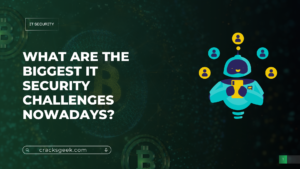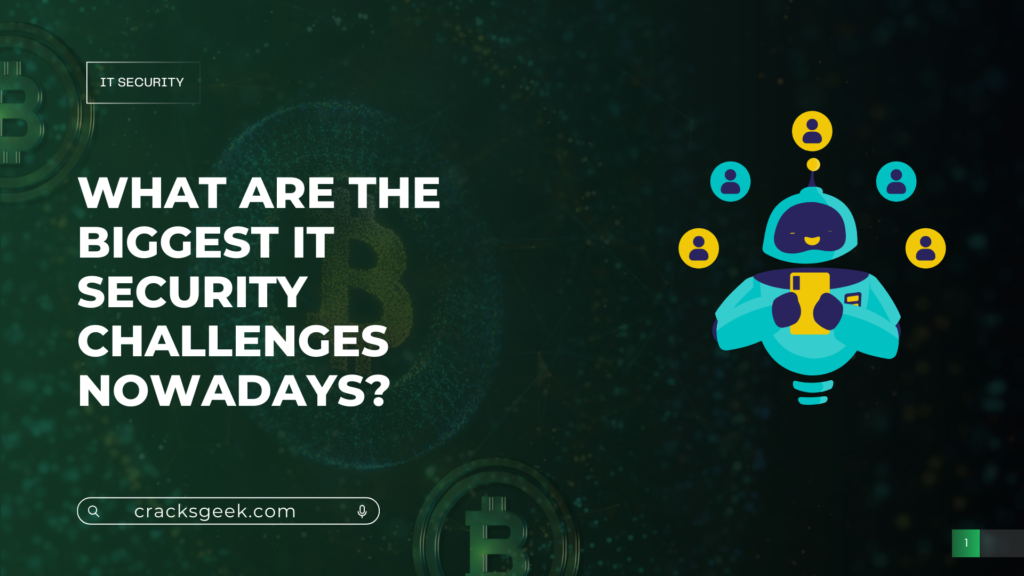
In the present era of the internet, business, government, and individuals put IT security in priority. The cyber threats are evolving rapidly, and organizations have to keep pace rapidly to ensure sensitive information and systems are not compromised. It ranges from attacks by ransomware to insider attacks, and it is a job of IT security experts to combat these with many challenges. Here are some of the largest IT security challenges in our times and why they are hard to overcome.
1. Ransomware Attacks
Ransomware is likely the scariest cyber attack on the globe today. Ransomware is a form of malware that encrypts a victim’s files and will decrypt them only for ransom in money. The attackers would like the money paid in some other form like a cryptocurrency that can’t be traced back. Hospitals, governments, and businesses have all been victims of the attack, losing man-hours and billions of dollars.
2. Social Engineering and Phishing
Phishing is also the most widespread method through which cybercriminals gain unauthorized access to a victim‘s personal data. Phishing is characterized by imitation emails, messages, or websites utilized in a bid to trick victims into giving login details, personal data, or bank details. Social engineering methods are based on psychology because they make the victims believe that they are dealing with a person they know.
In spite of high-end email security software and filtering, phishing remains a threat as the attackers continuously change the modus operandi. Spear phishing, for example, is directed towards an individual or a company, and hence the mail seems to be very authentic. Organizations need to spend on employee cybersecurity awareness training and multi-factor authentication (MFA) implementation so that unauthorized access is prevented even if the passwords have been compromised.
3. Insider Threats
Not all security threats are from external hackers—some insiders also do. Insiders are those employees, contractors, or business partners who take advantage of their authorized access to steal information, disrupt operations, or leak confidential information inappropriately. Insider threats of this kind are immensely hard to identify since insiders already have authorized access.
The insider threats are motivated by motivators that may be monetary incentives as a motivator to some employees, frustrations, and complacency by others. Proper access controls, monitoring of user behavior, and the use of behavior analytics for detecting anomaly in behavior must be done by organizations. Compulsory security awareness training and instilling a good organizational culture will equally do an excellent job of eradicating cases of insider threat.
4. Cloud Security Threats
Organizations have shifted their data and applications to the cloud, and this has resulted in the increase of security threats. Cybercriminals are targeting the cloud platforms through misconfiguration, inadequate authentication, and open APIs. The majority of organizations are under the false impression that security rests with the cloud providers and hence have weaknesses in their defense.
Cloud security is provided by shared responsibility under which there is some level of security that can be handled by both the customer and the provider. Companies should implement duly their cloud infrastructure, use the encryption mechanism, and establish strong access controls. Ongoing monitoring and compliance with industry regulations ensures risks from use of the cloud are eliminated.
5. IoT (Internet of Things) Vulnerabilities
The expansion of IoT devices—i.e., domestic smart devices, industrial sensors, and healthcare devices—has also brought with it new security risks. Most of the IoT devices have weak security features, thereby making them a soft target for hacker attacks. Hackers exploit vulnerabilities in IoT devices to attack, steal data, or gain unauthorized network access.
One of the biggest issues with IoT security is that it is difficult to patch devices. The majority of IoT devices are never patched with security patches and are open to attacks. Segmentation of the network must be ensured, IoT traffic needs to be monitored, and secure authentication needs to be done in order to avoid IoT-based cyberattacks.
6. AI-Powered Cyber Threats
Artificial intelligence (AI) is revolutionizing almost all industries, but it introduced new IT security risks. The attackers are employing AI to automate attacks, generate more advanced phishing emails, and evade conventional security controls. AI-based malware can learn security controls in real-time and become increasingly difficult to detect and block.
To counter AI-based attacks, organizations also need to employ AI in security. AI-based security systems can scan vast amounts of data to detect unusual patterns and combat threats more efficiently. Organizations need to be careful and update their security systems every now and then to combat constantly new AI-based attacks.
7. Supply Chain Attacks
Supply chain attacks utilize third-party vendor weaknesses, software vendors, or suppliers as a point of entry to open a doorway into a larger organization. Cyber attackers take over established vendors instead of targeting a business. They find unauthorized ways into critical systems and information. Some of the largest supply chain attacks, such as the SolarWinds attack, have firsthand demonstrated the potential of such attacks.
Supply chain security management must be imposed by companies through effective screening of their suppliers, strict execution of security measures, and regular surveillance on third-party access. Zero-trust security paradigms, wherein all participants will never be trusted by default, can forestall supply chain attacks.
8. Cybersecurity Skills Shortage
The most appropriate IT security problem confronting us today is the shortage of cybersecurity experts. Since the sophistication of cyber attacks has increased, companies find it difficult to hire qualified individuals to secure their networks. The shortage of skills leaves most companies exposed to attacks because of poor security controls and delayed responses to threats.
To cross this chasm, companies can fund cybersecurity training programs, collaborate with universities and schools, and even outsource to MSSPs. Diversity and inclusion could also be replicated in the cyber space to induct new professionals.
Conclusion
Security technology is a dynamic advancing edge in a conflict against cybercrime by cybersecurity. Cloud vulnerability, insider attack, and phishing and ransomware are the issues to be fought against by pro-active security measures by business firms. Investment in cybersecurity awareness, leveraging new technologies, and following best practices are countermeasures that fight against them. Regardless of how ever-shifting and continuously changing cybercrime is, businesses need to be as proactive and put cybersecurity inside business.





